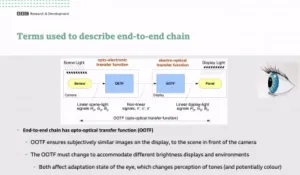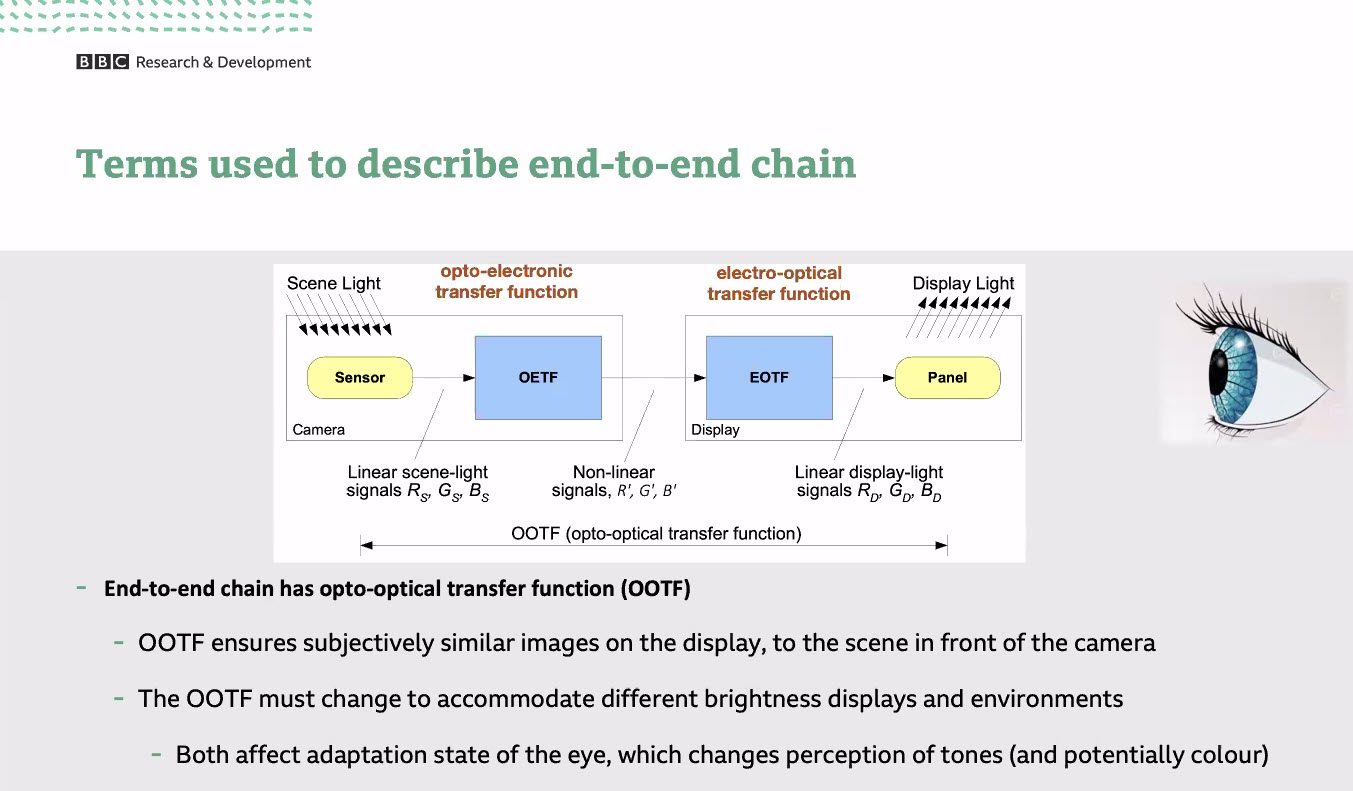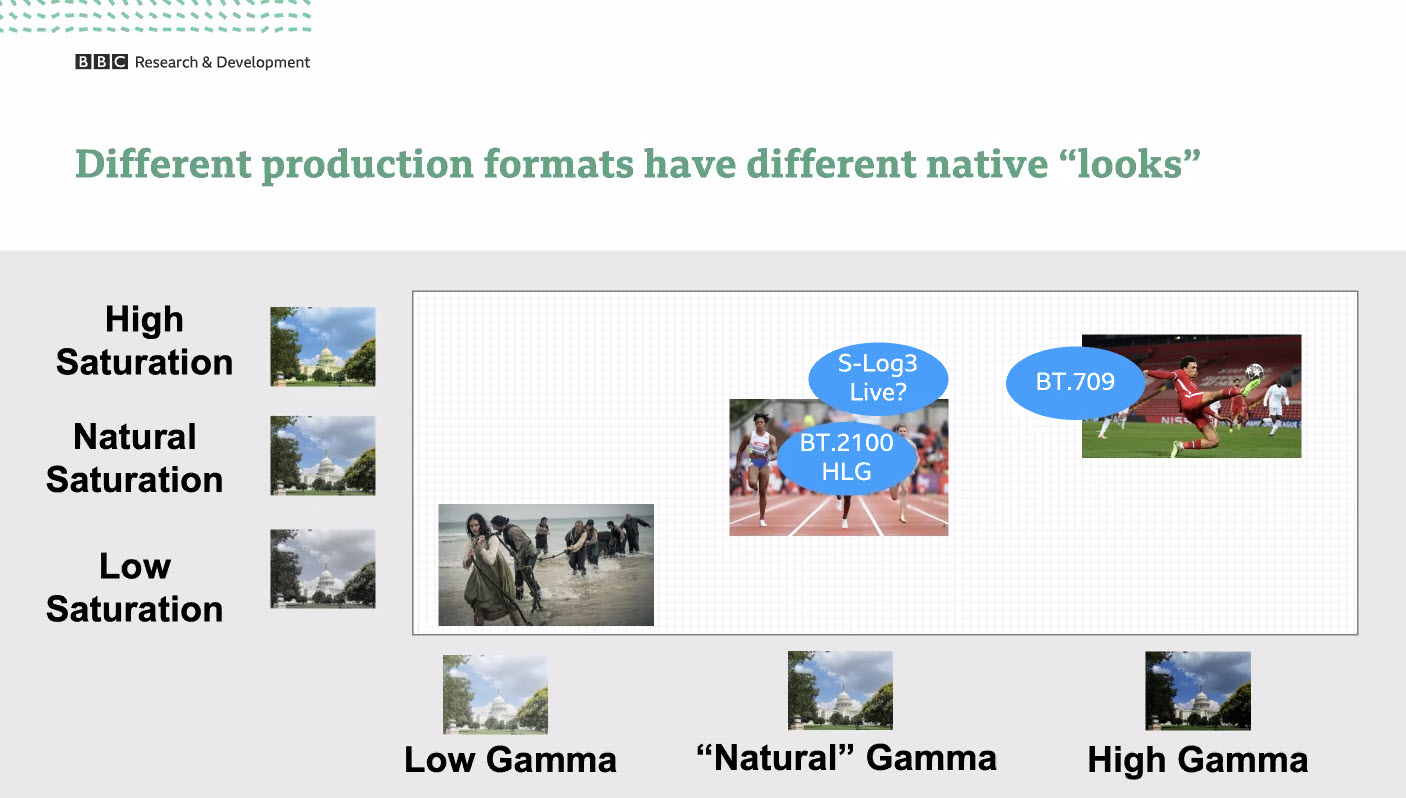The SMPTE UK chapter had an event – originally planned as as in-person event but later mutated to a virtual video – to visit the BBC’s R&D department. It promised some information on the use of HLG in sports broadcasting, so I arranged to attend the event.
Most of the event was on a broad range of topics related to the operations of the BBC and I’ll summarise those at the end of this article as I suspect that HLG is the most interesting topic for Display Daily readers. The speaker on the HLG topic was Simon Thompson. If you look at his bio you’ll see that he’s deep into HLG and video and his talk was ‘high bandwidth’. Unfortunately, the promised catch-up video after the event edited out his section of the event, because of content rights issues so I’m relying on my notes!
The talk was specifically related to the BBC’s experience of creating the UEFA Euro 2020 football competition, which took place in the summer of 2021, in HLG HDR. Thompson made a blog post about this which I have also referenced. The BBC, with NHK, was one of the originators of the HLG approach to HDR and so this was used for the production. We have written about HLG many, many times since 2015, so I won’t repeat it here, but for those that are not aware, HLG is an extension of the idea of gamma response to support HDR, with a curve between the brightest and darkest parts of an image, rather than the PQ approach which relates specific grey levels to particular levels of display brightness.
Thompson started by looking at the end to end aspects of the video chain from sensor to eye and he made the point that the opto-electronic transfer function (OETF) (from the camera to the signal) and the electro-optical transfer function (EOTF) combine to form an overall opto-optical transfer function (OOTF). The EOTF is not simply an inverse of the OETF because the overall function needs to take account of the way that the eye is adapted at the time of viewing. At a sports event outdoors, the eye will be very differently adapted to the way it will be when watching the TV at home and that will change the way that colours are perceived.
Early experience of the overall OOTF when using HLG showed that there were issues with the different colour response of the eye at different levels of brightness, so, Thompson said, the HLG curve was applied to the overall luminance and not to the individual colours.
Thompson highlighted that the SDR response curve in Rec. 709 is quite saturated. That is great for some types of content, such as sport, but not for all content. HLG was deliberately intended to be ‘more natural’ than Rec. 709 and so sport captured in HLG doesn’t look quite the same as traditional broadcast sport. Cameras often support SLog3, the Sony gamma curve, and that curve is less saturated than Rec. 709 but more than HLG. The BBC had discovered in 2019, when it covered the FA Cup Quarter Final in HLG that Grass Valley cameras needed adjustment, as did the Sony cameras. The Corporation found that the results tended to be quite different in the range of weather conditions for sport broadcasting.
All of these variables mean that there needs to be adjustment for the saturation and gamma response of sports content. The BBC adjusts the look of basic HLG content to get closer to the traditional look of sport and other genres (and has a proposal for a new section of BT.2408 on this kind of ‘painting’). However, the Euros this year took place in different countries with different broadcasters being responsible for particular matches. That was likely to pose a challenge if each applied a different ‘look’ to the content, so in the end UEFA asked for content to be provided with the ‘painting controls’ set to off to get more consistency between the different sources. The content was integrated at UEFA’s Broadcast Centre in Haarlem, in the Netherlands.
The integration of the different UK content sources was done by the BBC in the Dock10 independent studios in Manchester. There were many different isochronous feeds in SDR and HDR from outside and studio sources and Thompson showed the system flow which provided an HLG UltraHD stream via the BBC iPlayer that still ‘looked like football’.
Wembley, the UK’s national football stadium, there can be particular problems if the content is captured when there is a setting sun because of the wide range of lighting.
Thompson explained that there is ‘headroom’ in the video streams to EBU R.103. By taking care with the signals, you can use ‘overshoots’ to add detail to highlights and reduce ’round trip’ (HLG to 709 and then back) errors. He said that a lot of modern TVs can show white levels above the ‘100%’ level, so can preserve highlight detail.
HDR can also be a challenge where you have a lot of different steps in the creative process and its essential to audit the workflow to ensure that quality is maintained throughout the production process. It’s a lot more complicated than when everything was in Rec. 709.
Other topics
The SMPTE event also covered a lot of other topics being looked at by the R&D team at the BBC including:
-
sustainability – a particular challenge is trying to identify the environmental impact of cloud processing and services.
-
Distributed production using high speed interconnects can have a significant impact on the carbon footprint as well as reducing personal stress. XR production techniques using LEDs can also help
-
The importance of maintaining integrity in content, while keeping the workflow for journalists simple and fast. There may be ways of putting media in ‘a protected wrapper’ to ensure that it has not been tampered with. The BBC is working with CBC Radio, Microsoft and the New York Times on issues of ‘Protecting Trusted Media’
-
The future of TCP/IP and other internet protocols to improve the user experience of the internet for consumers.
-
Developments in audio such as ‘ambisonics’ where microphones are placed where the ears would be to provide immersive audio when headphones are used for listening
-
Detecting Deep Fakes including in audio.
-
More sophisticated audience research – beyond reach and audience size.
-
Cloud-based media production including, for example, dialogue enhancement.
-
Automated monitoring of multiple audio streams (for example for the 8 streams used for 12 hours per day in the BBC’s Nature Watch series. At the moment, these have to be monitored for ‘unsafe audio’ by humans)
-
Object-based media and experiments with ‘conversational stories’ – more like games than traditional drama.
This was a useful event and we are grateful to the SMPTE UK chapter for enabling our access. (BR)






